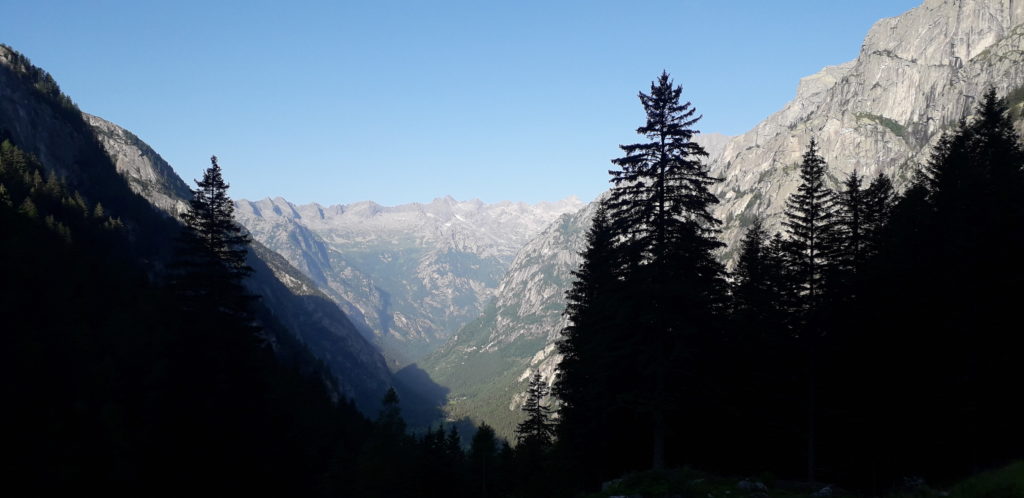Val di Mello Nature Reserve (Lombardy, Italy) and a controversial trail for more inclusiveness

Val di Mello Nature Reserve, established in 2009, is the largest protected area in Lombardy. It is a reserve that has been strongly desired by the local community, who mobilized for its preservation, in order to protect the extraordinary beauty of the landscape of this area. Val di Mello is already called a paradise for everyone, climbers, boulderers, hikers, families with children, school groups, the elderly and the disabled. The valley floor – a Special Protection Zone included in the European Natura 2000 network- is accessible to all from the main path, on the orographic right. On the orographic left there is a narrow trail that crosses a still unspoilt nature, among woods, fords, narrow passages between dry stone walls, large granite boulders and ancient steps, on which everyone, be it pupils on school trips, families with children or hikers can walk.
There are already two paths nearby for people with disabilities, a trail for the visually impaired at Bagni di Masino, and one in front of the boulder Sasso Remenno, called “sentiero sonoro” (sound path), both in a state of abandonment.
The matter in dispute is the idea – envisaged by Ersaf (Lombardy’s Regional Board for Agriculture and Forestry Services) and the regional administration (Region Lombardy) – to level out and widen the whole trail on the orographic left in order to create a path for people with disabilities. Works should begin in May and the new path should be opened to the public in October. But this is not the end of it. The aim – given that Region Lombardy has taken over the presidency of EUSALP (the Alpine Macro-Regional Strategy of the EU[1]) for one year from end of February– is to disseminate this approach to other countries and regions of the Alps as a “best practice”.
| A few questions arise: is there any difference between natural hindrances and architectonic barriers for people with disabilities? Are massive interventions on mountain trails justified in order to make them accessible for the disabled? Do we have to blow up rocks? Cut down trees, level out everything for the sake of inclusion? Aren’t we all disabled in some way before nature? Nature sets limits for all of us, but it also provides us with alternatives. Because nature is inclusive per se. There is always an alternative path, trail or climbing route for us all, disabled or not. We cannot expect nature to be changed for us. And instead of levelling out a trail in unspoilt nature, local/regional authorities could, for example, map all the trails in a certain area, determine the degree of difficulty for the disabled and develop a guidebook, an app, a website for them, just like “Accessible Dolomites” (http://www.visitdolomites.com/page1/dolomiti-accessibili/?lang=en), in the full spirit of the Declaration of Norcia, signed in 2003, when apps had not yet made their appearance. |
The Val di Mello project was kept secret for a long while, until the first vague rumours became more and more concrete and the local community, civil society, NGOs, Alpine guides and all those who have fallen in love with this beautiful valley started to put pressure on local authorities, Ersaf and Region Lombardy.
All we could read, after insisting for weeks on our right to access environmental information, was nothing but a project data sheet (to tell the truth a gross list, rather than a preliminary project) published at the beginning of April on Ersaf’s website. The few meetings with civil society convened by local authorities/Ersaf/Region Lombardy were little-publicised, last-minute (just to give an example, last week the venue of a meeting – that we had incidentally learned of by word of mouth- was changed a couple of hours before, to avoid “intruders”), upon invitation, most of the times inviting only a few NGOs (especially those who had declared themselves in favour of the project from the very beginning). Opposition started slow but then grew more and more every day, in real life and on social media. A petition was launched one month ago collecting more than 56,000 signatures to date. One after the other, climbers, boulderers, hikers, mountaineers (both with and without disabilities), their associations (including us and MW Italy, of course, as well as Valtellina/Lombardy Chapter of CAI, the Italian Alpine Club, and CAI SEM’s mountaineering and skimo school “Silvio Saglio”), local inhabitants, innkeepers and caterers, NGOs and all those who love the valley started to take a stand against the project. But Ersaf and Region Lombardy are already working on the executive project and, as you all probably know, when the executive project is ready civil society can no longer have a say in it.
You may wonder, what next? We will keep on fighting. We know that time is running up, but we will not give up. Nature is the most precious asset we have, all the more so in fragile mountain areas. And nature is the most inclusive environment on Earth.
And if you
want to join us, sign the petition at https://www.change.org/p/reglombardia-fermiamo-un-devastante-progetto-nel-cuore-della-riserva-naturale-della-val-di-mello and stay tuned, more news to come soon.
[1] The Macro-Regional Strategy for the Alpine Region is a platform for cooperation among 7 countries (France, Switzerland, Italy, Liechtenstein, Germany, Austria and Slovenia and their 48 regions in the Alpine area) aimed at cooperating in the spending of European funds to implement “macro-regional” projects that cannot be implemented by individual states/regions alone. But since the whole amount of money comes from Region Lombardy and the project is local and has no macro-regional scope whatsoever, it is quite hard to understand how it would fit in the strategy. Besides, no European fund would contribute to it.